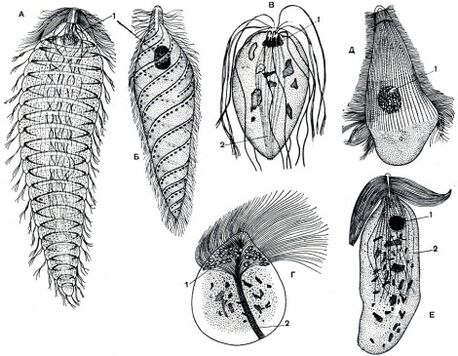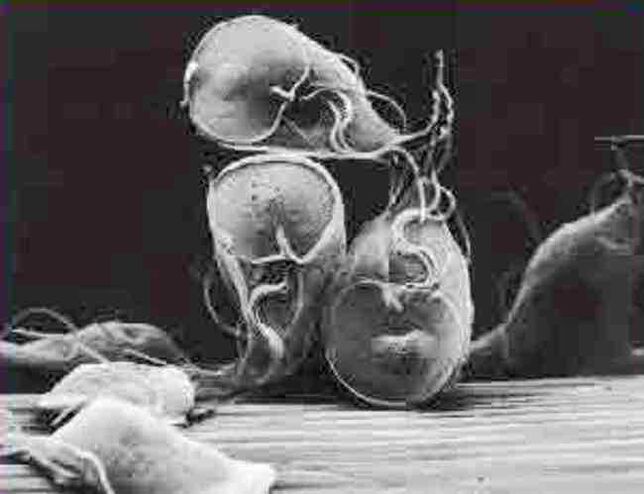Diseases caused by a variety of protozoa and helminths are common today. The danger of such diseases can be explained not only by complications and dysfunction in the body (protozoa and helminths in humans), but also by the complexity of diagnosing the disease due to the similarity of symptoms to various nonparasitic diseases.
Worms and protozoa cause:
- Gastrointestinal dysfunction (constipation, diarrhea, vomiting);
- allergic skin reaction;
- systemic poisoning;
- muscle and joint pain;
- Dehydration.
In order to avoid diagnostic errors and under-specified treatment procedures, which at best are ineffective at all and at worst can lead to complications, it is necessary to accurately determine the type of worm and the degree of infection associated with their body.
Infection routes of protozoan worms

All bugs enter the body from outside. The same goes for the simplest worms. In the environment, they live in soil, water bodies. In addition to not washing your hands and eating low-quality products, you can also get them at home through contact with carriers.
The main mechanism of any infection is usually oral feces, that is, a person simply swallows the eggs of the worm with food, water, and rarely some worm infection occurs when bitten by an infected insect.
The simplest worms that live in humans belong to the class of single-celled organisms. This infection is called protozoan disease. Depending on the type and extent of invasion, the course of the disease can be severe and even lead to the death of the patient.
What worms are called protozoa?
The simplest worms can have a body of a constant form (ciliate and flagellate) and a variable-bright representation of the amoeba. They are very small in size, ranging from 4-5 microns to 1-3 mm. The cells of these microorganisms usually have several nuclei. Pseudopodia, cilia and flagella act as motor organs. Depending on the species, the reproductive process occurs either by bifurcation or by a complex sexual method.
To protect themselves from adverse external conditions and further spread, the simplest worms turn into cysts, which are cells covered with a protective membrane. This allows them to transition from an immobile cyst to an active state if they enter a favorable environment.
Often, the carrier's body doesn't even notice the simplest of worms parasitizing it. In other cases, invasion results in the death of the host. For example, some antelope species in Africa are permanent "masters" of trypanosomes. Human bites of tsetse flies that carry these worms can infect them and cause sleeping sickness, which can be life-threatening.
The most studied protozoan worm
Human parasites belonging to the flagella class:

- Giardia is a parasite that usually lives in the gut, bile ducts, and liver of vertebrates (human and animal). They can be spread through food, water and other factors. This group of protozoa is responsible for diseases such as giardiasis - a dysfunction of the gastrointestinal tract, the small intestine. Many people infected with Giardia do not experience any noticeable symptoms.
- Leishmania is the simplest worm carried by mosquitoes. People are more likely to develop leishmaniasis after being bitten by insects. Signs of the disease are damage to the skin, mucous membranes and some internal organs, often fever and anemia are signs of the disease.
- Trypanosomes are protozoa transmitted by insects. When infected, they can cause trypanosomiasis. The disease course is longer. Depending on the type of trypanosome, various systems and organs can be affected.
- Amoeba dysentery lives in the gut. Invasion occurs in the form of a 4-nucleated cyst. Although dysentery amoeba is found almost everywhere, the most common cases of infection are recorded in tropical countries. Amoeba is the cause of human infectious protozoan diseases such as amebiasis. The clinical manifestation of the disease is ulcerative colitis, which is characterized by recurrence and exacerbation. There are also cases of parenteral forms of amebiasis -- these protozoan worms travel from the gut to other organs and even to the skin. The last form of the disease is called cutaneous amebiasis - in the buttocks and perineum, there are visible signs of ulcerative necrosis.
- Trichomonas cause trichomoniasis. Currently, several Trichomonas subspecies have been studied. The intestinal tract, its parasitic site is in the large intestine, and the parasites do little harm to the intestinal tract. The parasitic area of Trichomonas in the urogenital tract, as the name suggests - the urogenital system. Infection is through sex. This protozoan subspecies is responsible for diseases such as trichomoniasis. This infectious disease manifests as inflammation of the genitourinary system. Trichomonas oralis lives in the mouth and is not dangerous to humans.
The sporophyte species of protozoa are represented by Plasmodium and Coccidia:
- Plasmodium, which is transmitted by mosquitoes and causes malaria, is the simplest microorganism. It lives in the blood. Malaria infection with this parasite presents with the following symptoms: hypochromic anemia, fever, and enlargement of organs such as the liver and spleen.
- Coccidia are protozoa that live in the intestinal epithelium of many animals. Many species of coccidia are causative agents of diseases such as coccidiosis. In humans, the disease occurs with mild intoxication and the phenomenon of gastroenteritis or enteritis.
Ciliates: balantidia. This isolation of protozoa that lives in the large intestine is responsible for diseases such as balantidiasis.
Diagnosis and treatment of protozoan worms
Many times, when worms appear in the body without symptoms, the disease goes undiagnosed for a long time. Invasion is suspected by specific symptoms, which can only be detected by laboratory tests of feces, urine, blood, and fluids obtained from puncture of various organs and systems.
In medical practice, the following general principles apply to the treatment of protozoal invasions:
- antiparasitic drugs;
- non-steroidal anti-inflammatory drugs;
- antidote;
- With the manifestation of secondary bacterial infection, antibiotics in the narrow sense.
Depending on the type of protozoan worm and how aggressive it is, your doctor will prescribe specific treatments.



































